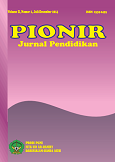KEMAMPUAN MAHASISWA DALAM MENYELESAIKAN MASALAH MATEMATIKA BERDASARKAN KERANGKA TUGAS MATEMATIKA TAKSONOMI STEIN
DOI:
https://doi.org/10.22373/pjp.v5i2.3360Keywords:
Menyelesaikan Masalah, Kerangka Tugas MatematikaAbstract
Ujicoba ini bertujuan melihat kemampuan mahasiswa dalam menyelesaikan soal-soal matematika tingkat SD/MI berdasarkan kerangka tugas matematika taksonomi Stein. Kerangka tugas dimaksud meliputi: menghafal, prosedur tanpa koneksi, prosedur dengan koneksi, dan bekerja dengan matematika. Soal yang diberikan ada 4 butir dan tertutup pada empat bidang konten: geometri, pengukuran, pecahan dan perbandingan. Secara umum, kemampuan mahasiswa Prodi PGMI dan Prodi Pendidikan Matematika UIN Ar-Raniry yang menjadi peserta tes dalam uji coba ini dapat dikategorikan pada tingkat kognitif rendah, kebanyakan mahasiswa belum sampai pada tingkat kognitif yang tinggi karena tidak mampu menjawab soal pada tingkat bekerja dengan matematika, bahkan masih banyak mahasiswa yang tidak bisa menjawab soal pada kategori menghafal. Namun kesimpulan ini tidak dapat digeneralisasikan untuk keseluruhan mahasiswa, karena sampel yang diambil tidak representatif.References
Helena P. Osana et al. (2006), The Role of Content Knowledge and Problem Features on Preservice Teachers’ Appraisal of Elementary Mathematics Tasks, Journal of Mathematics Teacher Education. Volume 9, Number 4, 347-380, DOI: 10.1007/s10857-006-4084-1, ISSN-1386-4416. [online]. Tersedia http://www.springerlink.com/content/m302537vm1603635/
Hudoyo dan Sutawijaya. (1998). Pendidikan Matematika I. Jakarta. Dirjen Dikti Depdiknas
Krulik, Sthepen dan Rudnick, Jesse A. (1995). The New Sourcebook for Teaching Reasoning and Problem Solving in Elementary School. Temple University : Boston.
Marsound, D. (2005). Improving Math Education in Elementary School : A Short Book for Teachers. Oregon : University of Oregon. [online]. Tersedia http://darkwing.uoregon.edu/.../ElMath.pdf
Peraturan Menteri Pendidikan Nasional 16/2007 tentang Standar Kualifikasi Akademik dan Kompetensi Guru.
Downloads
Published
Issue
Section
License
- Authors retain copyright and grant the journal right of first publication with the work simultaneously licensed under a Creative Commons Attribution License that allows others to share the work with an acknowledgment of the work's authorship and initial publication in this journal.
- Authors are able to enter into separate, additional contractual arrangements for the non-exclusive distribution of the journal's published version of the work (e.g., post it to an institutional repository or publish it in a book), with an acknowledgment of its initial publication in this journal.
- Authors are permitted and encouraged to post their work online (e.g., in institutional repositories or on their website) prior to and during the submission process, as it can lead to productive exchanges, as well as earlier and greater citation of published work (See The Effect of Open Access).

